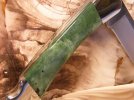Hi, all.
Ah, yes, the Jade texture...
Shawn, the jade on the Mercator is a California variety, and it looks like Mike's scales are Siberian or British Colombian, though you can not classify any Nephrite jade simply by where it comes from, as there are so many variations in the mineral. Nephrite Jade is not a simple, monolithic structure, like jasper (usually a solid microcrystalline quartz) which can be uniform throughout. Jade contains several structures with fibrous masses, mainly tremolite and actinolite. The interlocking fibers are why it is so tough, one of the toughest (most resistant to breakage) minerals known.
Of course jadeite and nephrite are two separate minerals, but what is mostly used is nephrite. Imperial jadeite is some of the most sought after and hardest to find (and expensive) jade. Consequently, some Nephrites have been misidentified as Imperial Jade. Nephrite is known to be the oldest jade ever used; implements and carvings have been found over 4,000 years old.
In finishing, All nephrite tends to pull and have a textured surface like the skin of lemons or oranges, which is normal. A really interesting thing about the nephrite is that it is acutally more elastic than steel, and can withstand tremendous pressures.
Nice stone work Mike. When are you going to start making the blades? With the work you're doing, it should be a natural progression for you!
Jay
 I am REALLY hoping for a pleasant uplifting experience. I haven't a clue how he stumbled onto my stone works...
I am REALLY hoping for a pleasant uplifting experience. I haven't a clue how he stumbled onto my stone works...

